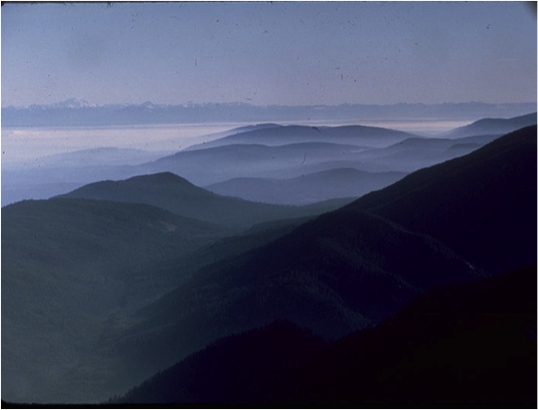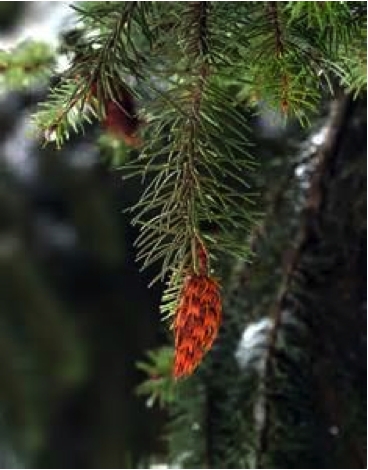Douglas Fir : Myth
A long time ago, back towards the beginning of things, before the animals and plants were as different from each other as they are now, there was a great forest. The forest was filled with trees and birds and flowers and creatures of all kinds. The trees grew tall and were spread over such a range that one could not see the where they ended. For countless years, the forest had prospered; everything was green and the animals were rarely hungry. One year, after a spring that was dryer than usual, came a summer that was hot, hotter than any summer most trees had seen in living memory. A day came when storm clouds built on the horizon until their tops stretched to the stars. A fierce wind blew them down from the mountains and lightning flashed, as hail flew and the rain pelted the land. After the storm had passed, the inhabitants began to peek their heads out and take stock of the damage. Several of the tallest trees had been struck by bolts of lightning and were broken and lifeless amidst the health of the forest. At the base of one of the snags, the lightning had started a fire. Within days of the storm, the blaze, fed by the dry brush and deadfall and coaxed on by the wind and heat, had become a wildfire of such a magnitude and power as had not been seen before and seldom since. As the flames spread, the forest creatures ran and flew before it, crying for all to flee.
In those days, animals were much friendlier and constantly helping one another; the fox had not his teeth and the hawk not her talons, the bears ate only berries and coyotes the grass. As such, there was trust between all beasts; how the fox gained his teeth and the bear her taste for meat are, of course, other stories. But as they all fled before the great fire, a helping paw was offered to any animal in need and several of the smaller creatures rode on the backs of those larger. Despite their best efforts, there seemed to be no escaping the roar of burning wood, the choking smoke and the constant heat of the sparks leaping out.
Now, the trees were also, as much as they were able, prone to helping the other members of the forest community. As the birds and beasts ran from the flames, most trees were incapable of offering any aid, as they were watching their own doom advance towards them. However, on one ridge there was a group of trees that did not fear the fire as much as their brethren, their bark was thick and able to withstand the heat. Blindly fleeing the menace of the fire, the creatures headed towards this ridge and its tall guardians. As the first entered the, as yet untouched, grove, the trees bent their lowest limbs down and told the animals to climb up as best they could and take shelter in the branches. Frantic and desperate for their survival, all the forest beings complied. When the last weasel and the last deer had been lifted to safety, the trees raised their branches from the ground and prepared to withstand the fire.
Perhaps because of their small size, perhaps because of the last minute struggle to get into the trees, left scurrying on the forest floor were all the mice in that part of the forest. Of course, this tragic mistake was realized quite quickly, but all the branches were filled with the other animals. The fire was creeping up the ridge as the mice tried to find a place to hide. The trees, not wishing another creature of the forest to burn, told the mice to crawl into their cones, the only open place left. Scrambling up the trunks as the fire entered the grove, the mice dived head first into the cones.
It was a terrifying experience for everyone, listening to the growl of the flames as they licked along the ground and watching anything unfortunate enough to be left on the ground crisp and smoke. Soon enough the blaze had moved on to the next stand of trees, then the one beyond that and so on until the plums of smoke were on the far horizon. The trees lowered their branches and let each creature down. As the animals wandered back towards their old homes, the trees realized one animal was still in its hiding place. The mice, who had thrown themselves into the cones at the last minute, were still there. So great had been their fright and so forceful their dives that each mouse was stuck where it had jumped. No matter how they wiggled and squirmed, the mice could not get free. The trees, who considered their part done now that they had helped the animals survive, soon gave up on trying to dislodge the mice and let them be.
After many years passed and the forests grew back and the animals became more like who they are today, the mice butts, now thin and shriveled with age, still stick out of the cones. Then, in 1825, a man called David Douglas arrived to the forest and named these trees, and their distinctive cones are still used to identify them today.
This story has been retold as I recall hearing it from my childhood. The sources I list retell other variations of this story. My retelling is in no way supposed to represent the beliefs, traditions, and/or values of any Native American tribes, or other indigenous groups; if some parts of my story do correspond to these traditional stories it is purely by coincidence.



